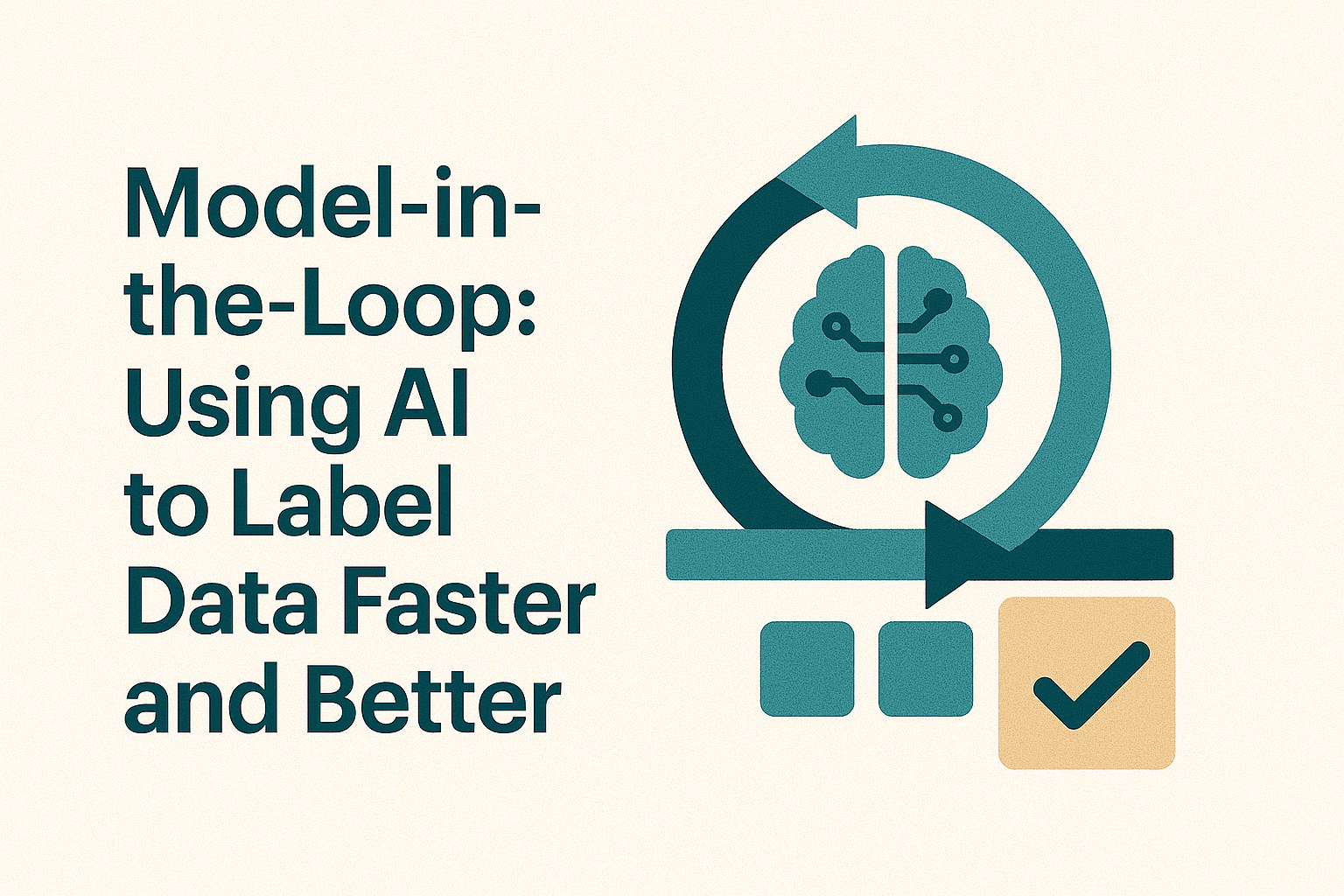
Model-in-the-Loop: Using AI to Label Data Faster and Better
Model-in-the-Loop: Using AI to Label Data Faster and Better
For any enterprise building AI at scale, data annotation is both the foundation and the bottleneck. The larger the dataset, the harder it becomes to label everything manually without burning resources, timelines, and workforce stamina. But there’s one strategy helping top AI teams break this cycle—model-in-the-loop (MITL) labeling.
In this approach, AI models don’t just consume labeled data. They help generate it. By using pretrained models to predict labels for raw or weakly labeled data, organizations can bootstrap large datasets quickly, reduce human workload, and direct expert attention only where it’s most needed.
When done right, model-in-the-loop systems not only accelerate annotation velocity but improve model performance by tightening the feedback loop between learning and labeling.
In this blog, we break down how model-in-the-loop labeling works, where pseudo-labeling fits in, and how enterprises can operationalize this workflow to build smarter AI systems faster.
What Is Model-in-the-Loop Labeling?
Model-in-the-loop (MITL) refers to using trained or partially trained models to assist human annotators by generating, suggesting, or validating labels during the data annotation process.
These model-generated labels are known as pseudo-labels—provisional labels that may be used as-is, verified by a human, or prioritized for SME review based on confidence.
Instead of treating annotation and training as two separate silos, MITL closes the loop—creating a dynamic feedback cycle where the model continuously contributes to its own improvement by identifying:
- High-confidence examples it can label
- Low-confidence cases it needs help with
- Ambiguous samples that require escalation
This approach shifts annotation from full manual effort to a hybrid system of AI pre-labeling, human validation, and active learning prioritization.
Key Techniques in Model-Assisted Labeling
Several strategies fall under the model-in-the-loop umbrella, each suited to different phases of dataset development:
1. Pseudo-Labeling
A pretrained or partially trained model is run on unlabeled data. Predictions above a confidence threshold are used as provisional labels. These pseudo-labels are then used to train a new version of the model—or validated by annotators to create ground truth.
Best suited for:
- Bootstrapping large datasets
- Iterative model improvement
- Tasks with clear class boundaries (e.g., sentiment analysis, object detection)
2. Label Suggestion and Confirmation
Models propose labels inside the annotation UI. Annotators simply confirm or correct. This reduces decision fatigue and improves speed—particularly in repetitive or long-tail classification tasks.
Best suited for:
- High-volume classification
- Named entity recognition
- Multilingual text labeling
3. Active Learning via Uncertainty Sampling
The model flags uncertain predictions (e.g., samples near decision boundaries or with low confidence scores) for prioritized human review. This ensures labeling effort is focused where the model stands to learn the most.
Best suited for:
- Model refinement
- Label efficiency optimization
- Training on sparse or expensive data
4. Model-Driven Edge Case Escalation
The model identifies outliers or class drift during labeling and routes them to senior annotators or SMEs. This ensures edge cases aren’t mislabeled and become silent model failures.
Best suited for:
- Regulated domains (e.g., finance, healthcare)
- Multimodal labeling
- Continual learning environments
FlexiBench supports all of these techniques—tailored by task type, industry, and throughput requirements.
Benefits of Model-in-the-Loop Annotation
Implementing MITL workflows unlocks performance at multiple levels:
Faster labeling cycles
Pre-filled or suggested labels drastically reduce annotator effort and increase throughput, especially in repetitive or low-variance datasets.
Higher label consistency
Model logic is inherently consistent. When verified or corrected by humans, it yields more uniform training data than purely manual efforts.
Optimized use of experts
SMEs and reviewers are routed only the most difficult or impactful examples—reducing overhead and maximizing knowledge application.
Continuous model improvement
With every iteration, the model improves and assists labeling more effectively—shortening the cycle from data to deployment.
Cost control at scale
By avoiding full manual labeling of every sample, MITL workflows reduce total annotation cost without compromising quality.
Challenges and How to Mitigate Them
Model-in-the-loop isn’t without risks. If implemented without safeguards, it can introduce label bias or reinforce incorrect logic.
Label propagation errors
If a model’s early predictions are flawed, pseudo-labeling can compound errors across the dataset. Mitigation: Set high confidence thresholds and validate with random sampling.
Overreliance on automation
Annotators may default to model suggestions even when unsure. Mitigation: Implement reviewer spot-checks and track confirmation rates.
Delayed drift detection
MITL systems trained on outdated data may miss new patterns. Mitigation: Integrate model monitoring and retraining triggers tied to data quality metrics.
FlexiBench mitigates these risks with real-time QA feedback, confidence scoring, human override logging, and per-batch performance analysis—ensuring pseudo-labels remain an accelerator, not a liability.
How FlexiBench Operationalizes Model-in-the-Loop Workflows
At FlexiBench, we enable MITL workflows through:
- API integrations with client-side models to push predictions into labeling queues
- Confidence-based pre-labeling with customizable thresholds and human override workflows
- Active learning modules that prioritize uncertain data for review
- Edge case routing logic that auto-assigns low-confidence or anomalous predictions to expert annotators
- Audit trails and performance reports that track model-assisted label quality over time
Our infrastructure is built to scale MITL without sacrificing accuracy, transparency, or compliance—making it ideal for large teams working across multimodal, multilingual, and high-risk datasets.
Conclusion: AI That Helps Build AI
Model-in-the-loop workflows represent a shift in how AI systems are built. No longer passive recipients of data, models become active collaborators—accelerating their own learning through structured human-machine interaction.
For enterprises scaling up machine learning, this is not a novelty—it’s a necessity. MITL labeling improves data quality, speeds up iteration, and makes AI development more sustainable in high-volume environments.
At FlexiBench, we help organizations embed this intelligence into their pipelines—because the future of data labeling isn’t just about labor. It’s about leverage.
References
Google Research, “Pseudo-Labeling and Semi-Supervised Learning at Scale,” 2023 Stanford HAI, “Model-in-the-Loop Annotation Systems: Architecture and Outcomes,” 2024 McKinsey Analytics, “Label Smarter, Not Harder: Optimizing AI with Human-AI Loops,” 2024 FlexiBench Technical Overview, 2024



.png)
